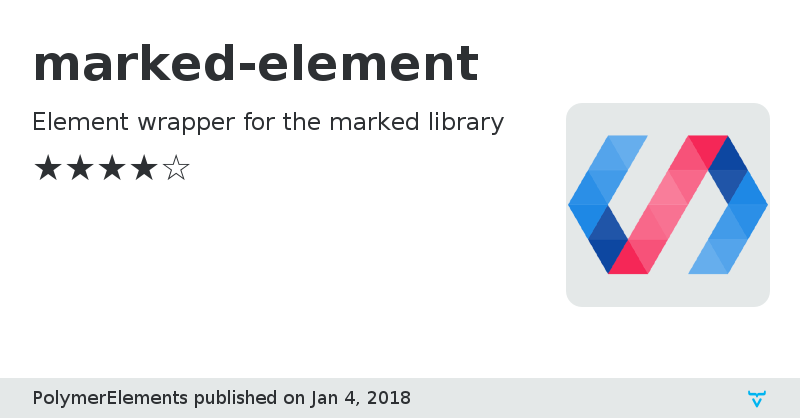marked-element - Vaadin Add-on Directory
Element wrapper for the marked library
View on GitHub
Online Demo
Documentation
GitHub Homepage
Issue tracker
License
marked-element version 0.8.0
### Dependencies
* polymer#Polymer/polymer#v0.8.0-rc.4
* marked#~0.3.3
marked-element version 0.8.1
### Dependencies
* polymer#Polymer/polymer#v0.8.0-rc.4
* marked#~0.3.3
marked-element version 0.8.2
### Dependencies
* polymer#Polymer/polymer#v0.8.0-rc.6
* marked#~0.3.3
marked-element version 0.8.3
### Dependencies
* polymer#Polymer/polymer#v0.8.0-rc.7
* marked#~0.3.3
marked-element version 0.9.0
### Dependencies
* polymer#Polymer/polymer#v0.9.0-rc.1
* marked#~0.3.3
marked-element version 0.9.1
### Dependencies
* marked#~0.3.3
* polymer#Polymer/polymer#^0.9.0
marked-element version 0.9.2
### Dependencies
* marked#~0.3.3
* polymer#Polymer/polymer#^0.9.0
marked-element version 1.0.0
### Dependencies
* marked#~0.3.3
* polymer#Polymer/polymer#^1.0.0
marked-element version 1.0.1
### Dependencies
* marked#~0.3.3
* polymer#Polymer/polymer#^1.0.0
marked-element version 1.0.2
### Dependencies
* marked#~0.3.3
* polymer#Polymer/polymer#^1.0.0
marked-element version 1.1.0
### Dependencies
* marked#~0.3.3
* polymer#Polymer/polymer#^1.0.0
marked-element version 1.1.1
### Dependencies
* marked#~0.3.3
* polymer#Polymer/polymer#^1.1.0
marked-element version 1.1.2
### Dependencies
* marked#~0.3.3
* polymer#Polymer/polymer#^1.1.0
marked-element version 0.0.1
### Dependencies
* marked#~0.3.3
* @polymer/polymer#^1.2.5-npm-test.2
marked-element version 0.0.3
### Dependencies
* marked#~0.3.3
* @polymer/polymer#^1.2.5-npm-test.2
marked-element version 1.1.3
### Dependencies
* marked#~0.3.3
* polymer#Polymer/polymer#^1.1.0
marked-element version 1.2.0
### Dependencies
* marked#~0.3.3
* polymer#Polymer/polymer#^1.1.0
marked-element version 1.3.0
### Dependencies
* marked#~0.3.3
* polymer#Polymer/polymer#^1.1.0
marked-element version 1.3.1
### Dependencies
* marked#~0.3.3
* polymer#Polymer/polymer#^1.1.0
marked-element version 1.3.2
### Dependencies
* marked#~0.3.3
* polymer#Polymer/polymer#^1.1.0
marked-element version 1.4.0
### Dependencies
* marked#~0.3.3
* polymer#Polymer/polymer#^1.1.0
marked-element version 1.4.1
### Dependencies
* marked#~0.3.3
* polymer#Polymer/polymer#^1.1.0
marked-element version 1.4.2
### Dependencies
* marked#~0.3.3
* polymer#Polymer/polymer#^1.1.0
marked-element version 2.0.0
### Dependencies
* marked#~0.3.6
* polymer#Polymer/polymer#1.9 - 2
marked-element version 2.1.0
### Dependencies
* marked#~0.3.6
* polymer#Polymer/polymer#1.9 - 2
marked-element version 2.1.1
### Dependencies
* marked#~0.3.6
* polymer#Polymer/polymer#1.9 - 2
marked-element version 2.2.0
### Dependencies
* marked#~0.3.6
* polymer#Polymer/polymer#1.9 - 2
marked-element version 2.3.0
### Dependencies
* marked#~0.3.6
* polymer#Polymer/polymer#1.9 - 2
marked-element version 3.0.0-pre.1
### Dependencies
* @polymer/polymer#^3.0.0-pre.1
marked-element version 2.3.1
### Dependencies
* marked#~0.3.6
* polymer#Polymer/polymer#1.9 - 2
marked-element version 2.3.2
### Dependencies
* marked#~0.3.6
* polymer#Polymer/polymer#1.9 - 2
marked-element version 2.3.3
### Dependencies
* marked#~0.3.9
* polymer#Polymer/polymer#1.9 - 2
marked-element version 3.0.0-pre.2
### Dependencies
* @polymer/polymer#^3.0.0-pre.1
marked-element version 3.0.0-pre.3
### Dependencies
* @polymer/polymer#^3.0.0-pre.3
marked-element version 3.0.0-pre.4
### Dependencies
* @polymer/polymer#^3.0.0-pre.4
marked-element version 3.0.0-pre.6
### Dependencies
* @polymer/polymer#^3.0.0-pre.6
marked-element version 3.0.0-pre.7
### Dependencies
* @polymer/polymer#^3.0.0-pre.7
marked-element version 3.0.0-pre.8
### Dependencies
* @polymer/polymer#^3.0.0-pre.7
marked-element version 3.0.0-pre.10
### Dependencies
* marked#~0.3.9
* @polymer/polymer#^3.0.0-pre.10
marked-element version 2.3.4
### Dependencies
* marked#~0.3.9
* polymer#Polymer/polymer#1.9 - 2
marked-element version 2.4.0
### Dependencies
* marked#~0.3.9
* polymer#Polymer/polymer#1.9 - 2
marked-element version 3.0.0-pre.11
### Dependencies
* marked#~0.3.9
* @polymer/polymer#^3.0.0-pre.10
marked-element version 3.0.0-pre.12
### Dependencies
* marked#~0.3.9
* @polymer/polymer#3.0.0-pre.12
marked-element version 3.0.0-pre.13
### Dependencies
* marked#~0.3.9
* @polymer/polymer#^3.0.0-pre.13
marked-element version 3.0.0-pre.14
### Dependencies
* marked#~0.3.9
* @polymer/polymer#^3.0.0-pre.13
marked-element version 3.0.0-pre.15
### Dependencies
* marked#~0.3.9
* @polymer/polymer#^3.0.0-pre.13
marked-element version 3.0.0-pre.16
### Dependencies
* marked#~0.3.9
* @polymer/polymer#^3.0.0-pre.13
marked-element version 3.0.0-pre.17
### Dependencies
* marked#~0.3.9
* @polymer/polymer#^3.0.0-pre.13
marked-element version 3.0.0-pre.18
### Dependencies
* marked#~0.3.9
* @polymer/polymer#^3.0.0
marked-element version 3.0.0-pre.19
### Dependencies
* marked#~0.3.9
* @polymer/polymer#^3.0.0
marked-element version 3.0.0-pre.20
### Dependencies
* marked#~0.3.9
* @polymer/polymer#^3.0.0
marked-element version 3.0.0-pre.21
### Dependencies
* marked#~0.3.9
* @polymer/polymer#^3.0.0
marked-element version 3.0.0-pre.22
### Dependencies
* marked#~0.3.9
* @polymer/polymer#^3.0.0
marked-element version 3.0.0-pre.23
### Dependencies
* marked#~0.3.9
* @polymer/polymer#^3.0.0
marked-element version 3.0.0-pre.24
### Dependencies
* marked#~0.3.9
* @polymer/polymer#^3.0.0
marked-element version 3.0.0-pre.25
### Dependencies
* marked#~0.3.9
* @polymer/polymer#^3.0.0
marked-element version 3.0.0-pre.26
### Dependencies
* marked#~0.3.9
* @polymer/polymer#^3.0.0
marked-element version 3.0.0
### Dependencies
* marked#~0.3.9
* @polymer/polymer#^3.0.0
marked-element version 3.0.1
### Dependencies
* marked#~0.3.9
* @polymer/polymer#^3.0.0